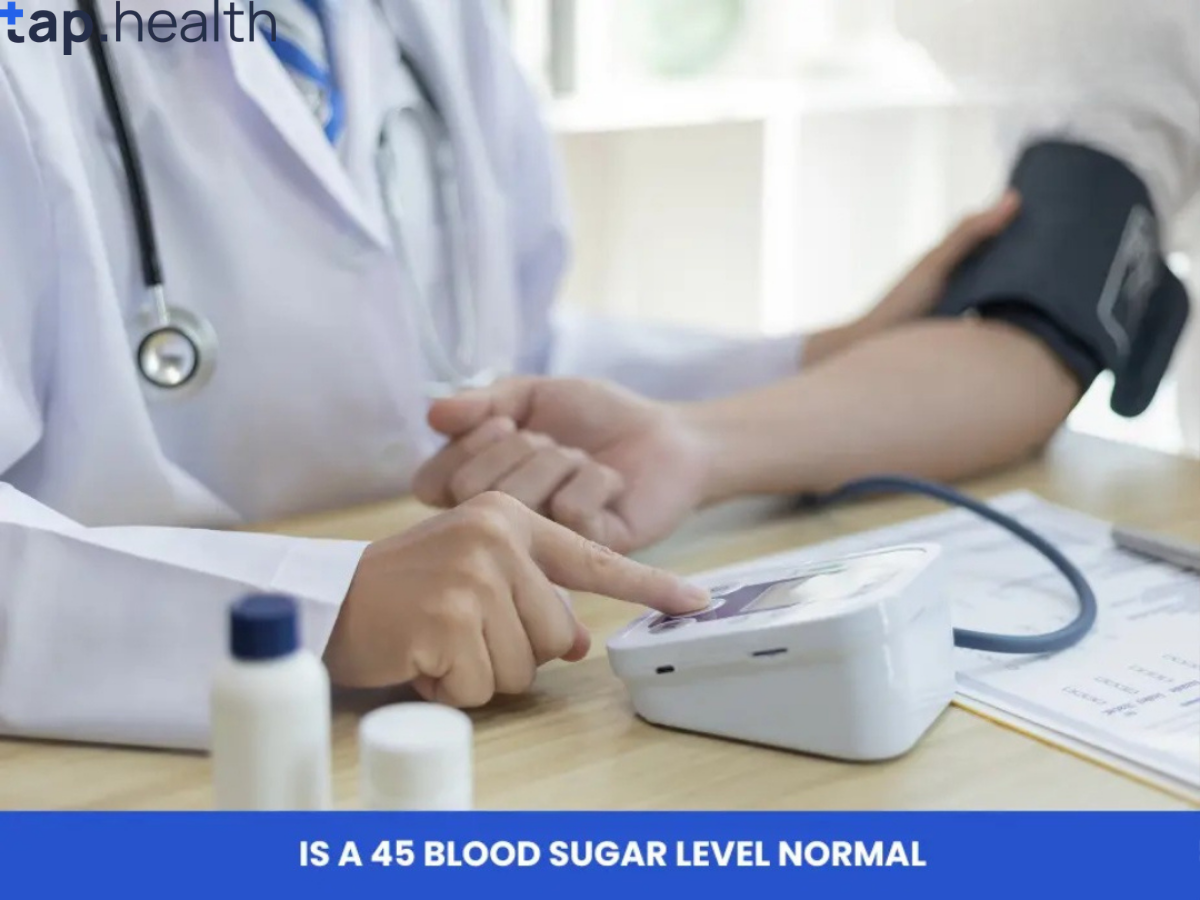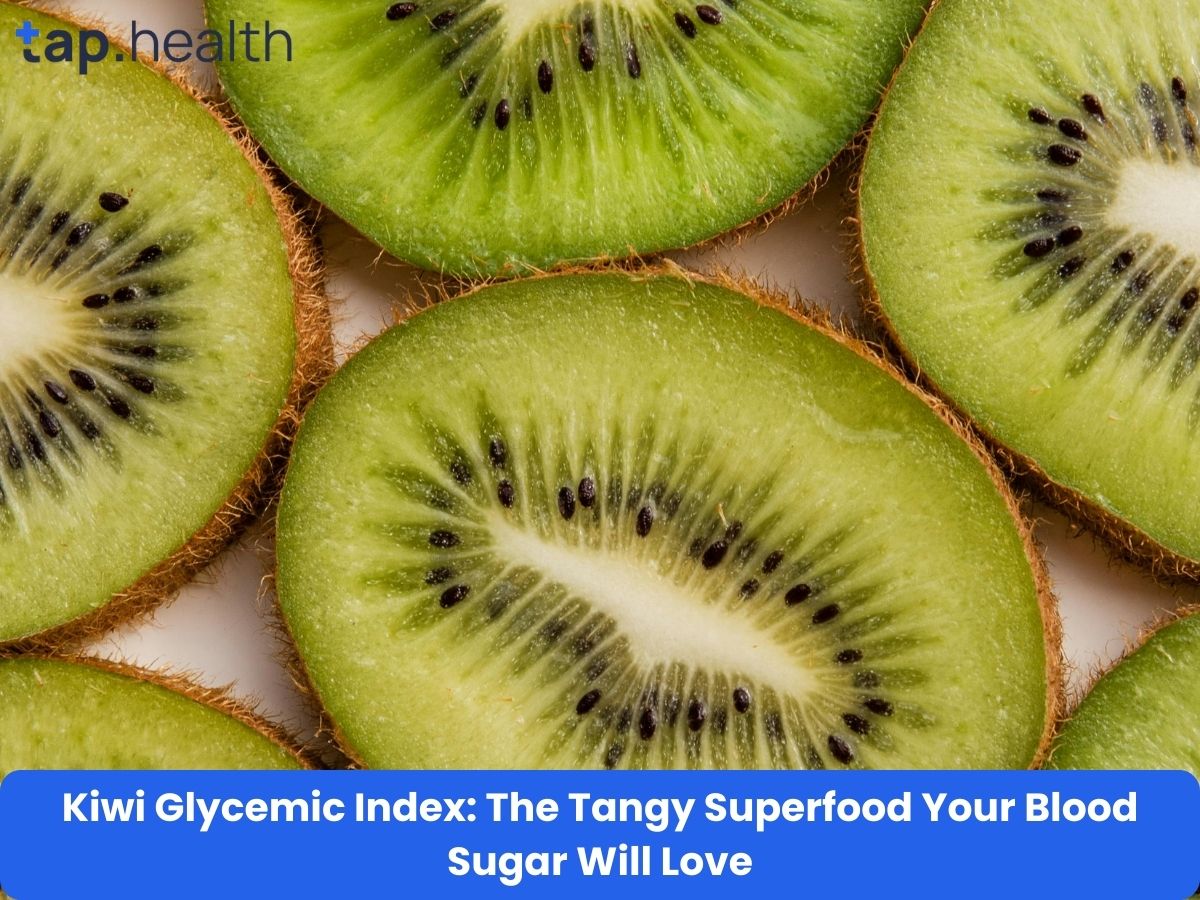Maintaining healthy blood sugar levels is essential for your overall well-being. But what does a sugar level of 45 mean? Is it normal? In this blog post, we’ll explore everything you need to know about blood sugar levels, focusing on whether a 45 mg/dL sugar level is within the normal range.
What Are Blood Sugar Levels?
Blood sugar, also known as glucose, is the primary source of energy for your body’s cells. Glucose comes from the food you eat and is transported through your bloodstream to cells all over your body. Insulin, a hormone produced by the pancreas, helps regulate blood sugar levels by allowing glucose to enter cells.
Maintaining balanced blood sugar levels is crucial. Too high or too low levels can lead to health problems. Understanding what your blood sugar numbers mean can help you take control of your health.
How Blood Sugar is Measured
Blood sugar levels are typically measured in milligrams per deciliter (mg/dL). There are several ways to measure blood sugar:
- Fasting Blood Sugar Test: Measures blood sugar after an overnight fast.
- Postprandial Blood Sugar Test: Measures blood sugar two hours after eating.
- Random Blood Sugar Test: Measures blood sugar at any time, regardless of when you last ate.
- Hemoglobin A1c Test: Provides an average blood sugar level over the past two to three months.
Understanding these measurements helps in diagnosing and managing conditions like diabetes and hypoglycemia.
Normal Blood Sugar Levels
Blood sugar levels fluctuate throughout the day, influenced by factors like meals, physical activity, and stress. Here’s a general guideline for normal blood sugar levels:
- Fasting Blood Sugar (before eating): 70-99 mg/dL
- Postprandial Blood Sugar (2 hours after eating): Less than 140 mg/dL
- Random Blood Sugar: Less than 140 mg/dL
These values are based on guidelines from authoritative health organizations like the American Diabetes Association (ADA) and the Centers for Disease Control and Prevention (CDC).
Understanding Blood Sugar Ranges
Maintaining blood sugar within the normal range is vital for energy, mood stability, and preventing long-term health issues. Blood sugar levels that are consistently too high can lead to diabetes complications, while levels that are too low can cause immediate health risks.
Factors Affecting Blood Sugar Levels
Several factors can influence blood sugar levels, including:
- Diet: Types and amounts of carbohydrates consumed.
- Physical Activity: Exercise can lower blood sugar levels.
- Medications: Insulin and other diabetes medications affect blood sugar.
- Stress: Stress hormones can increase blood sugar levels.
- Illness: Certain illnesses can disrupt blood sugar balance.
Understanding these factors can help in effectively managing and maintaining healthy blood sugar levels.
Is a 45 Sugar Level Normal?
A blood sugar level of 45 mg/dL is considered low and is categorized as hypoglycemia. This level is below the normal fasting range and requires attention.
Understanding Hypoglycemia
Hypoglycemia occurs when blood sugar levels drop below the normal range. It can be dangerous if not addressed promptly. Common thresholds for hypoglycemia are:
- Mild Hypoglycemia: 70-50 mg/dL
- Moderate Hypoglycemia: 50-40 mg/dL
- Severe Hypoglycemia: Below 40 mg/dL
A level of 45 mg/dL falls into the moderate hypoglycemia category, which can lead to significant health issues if not treated quickly.
Impact of Low Blood Sugar
Low blood sugar affects the brain and other vital organs since glucose is their primary energy source. Symptoms can range from mild discomfort to life-threatening conditions.
Long-Term Risks of Severe Hypoglycemia
Repeated episodes of severe hypoglycemia can lead to:
- Cardiovascular Problems: Increased risk of heart issues.
- Neurological Damage: Potential long-term brain damage from insufficient glucose.
- Impaired Awareness: Difficulty recognizing future hypoglycemia episodes.
Therefore, it’s crucial to address low blood sugar promptly and prevent recurrent episodes.
Causes of Low Blood Sugar (Hypoglycemia)
Several factors can cause blood sugar levels to drop to 45 mg/dL:
- Medications: Insulin or other diabetes medications can sometimes lower blood sugar too much.
- Skipping Meals: Not eating enough can cause blood sugar levels to fall.
- Excessive Alcohol Consumption: Drinking heavily without eating can lead to hypoglycemia.
- Intense Exercise: Engaging in vigorous physical activity without adjusting food intake or medication can lower blood sugar.
- Medical Conditions: Certain illnesses, such as liver disease or hormonal deficiencies, can cause low blood sugar.
- Hormonal Imbalances: Disorders affecting the adrenal or pituitary glands can disrupt glucose regulation.
- Reactive Hypoglycemia: Blood sugar drops after meals due to excessive insulin production.
Medications and Hypoglycemia
- Insulin Overdose: Taking too much insulin can cause blood sugar to plummet.
- Sulfonylureas: A class of medications for diabetes that increase insulin production.
Dietary Factors
- Irregular Eating Patterns: Skipping meals or irregular eating can destabilize blood sugar.
- High-Carb Meals without Balance: Consuming high-carbohydrate foods without adequate protein or fat can lead to rapid spikes and drops in blood sugar.
Lifestyle Factors
- Excessive Physical Activity: Without proper nutrition or medication adjustment, intense exercise can deplete blood sugar.
- Alcohol Consumption: Alcohol inhibits glucose production in the liver, leading to hypoglycemia, especially when consumed on an empty stomach.
Medical Conditions Leading to Hypoglycemia
- Liver Disease: Impaired glucose production.
- Kidney Disorders: Affect insulin clearance.
- Endocrine Disorders: Issues with adrenal or pituitary glands.
- Severe Infections: Can disrupt normal metabolic processes.
Understanding the underlying cause is crucial for proper management and prevention.
Symptoms of Low Blood Sugar
Recognizing the symptoms of hypoglycemia is vital for timely intervention. Common symptoms include:
- Shakiness or Tremors
- Sweating
- Rapid Heartbeat
- Dizziness or Lightheadedness
- Hunger
- Irritability or Mood Changes
- Confusion or Difficulty Concentrating
- Headaches
- Weakness or Fatigue
- Pallor (Pale Skin)
Severe Symptoms
In severe cases, hypoglycemia can lead to:
- Seizures
- Loss of Consciousness
- Coma
Neurological Symptoms
Low blood sugar affects the brain, leading to cognitive impairments such as:
- Difficulty Speaking
- Blurred Vision
- Lack of Coordination
Psychological Symptoms
Hypoglycemia can also cause psychological symptoms, including:
- Anxiety
- Irritability
- Aggression
Recognizing Severe Hypoglycemia
Severe hypoglycemia is a medical emergency. Symptoms include inability to eat or drink, seizures, or loss of consciousness. Immediate medical attention is required in such cases.
When to Seek Medical Help
A blood sugar level of 45 mg/dL is a medical concern. If you or someone you know has this level, take the following steps:
- Consume Fast-Acting Carbohydrates: Eat or drink something high in sugar, such as glucose tablets, fruit juice, or regular soda.
- Wait 15 Minutes: Allow time for the sugar to enter the bloodstream.
- Recheck Blood Sugar: If it’s still low, repeat the process.
- Seek Medical Help: If symptoms persist or worsen, call emergency services immediately.
Note: Individuals with diabetes should always follow their healthcare provider’s instructions for managing hypoglycemia.
When to Call Emergency Services
- Unconsciousness: If the person is unconscious and cannot swallow.
- Seizures: Any seizure activity requires immediate attention.
- Inability to Eat or Drink: When the person cannot safely consume carbohydrates.
- Persistent Symptoms: Symptoms do not improve after initial treatment.
Preparing for Emergencies
- Medical Identification: Wear a medical ID that indicates diabetes or other conditions prone to hypoglycemia.
- Emergency Contacts: Keep a list of emergency contacts readily accessible.
- Glucagon Kit: For severe hypoglycemia, a glucagon injection may be necessary. Ensure family and friends know how to use it.
What Should I Eat if My Blood Sugar is 45?
When your blood sugar drops to 45 mg/dL, it’s essential to act quickly to raise it to a safe level. Consuming the right types of foods can help stabilize your blood sugar promptly. Here’s what you should eat:
1. Fast-Acting Carbohydrates
Fast-acting carbohydrates are quickly absorbed into your bloodstream, providing an immediate boost to your blood sugar levels. Examples include:
- Glucose Tablets: Specifically designed to raise blood sugar quickly.
- Fruit Juice: A small glass (about 4 ounces) of orange juice or apple juice.
- Regular Soda: About 4 ounces of a non-diet soda.
- Candy: Hard candies like jellybeans or gummy bears (check the packaging for sugar content).
- Honey or Sugar: A tablespoon of honey or table sugar dissolved in water.
Dosage: Typically, consume about 15 grams of fast-acting carbohydrates and wait 15 minutes before rechecking your blood sugar.
2. Complex Carbohydrates and Protein (After Initial Recovery)
Once your blood sugar levels start to stabilize, it’s important to consume foods that help maintain your blood sugar levels over a longer period. These include:
- Whole Grain Bread or Crackers: Provides sustained energy.
- Peanut Butter or Cheese: Adds protein to help keep blood sugar levels steady.
- Fruit: A piece of fruit like an apple or banana.
- Yogurt: Preferably plain or low-sugar varieties.
Example Combination: Whole-grain toast with peanut butter or a slice of cheese with whole-grain crackers.
3. Avoid High-Fat Foods
While it’s important to raise your blood sugar quickly, avoid foods high in fat as they can slow down the absorption of sugar. Focus on carbohydrates and some protein instead.
4. Stay Hydrated
Drinking water can help your body process and absorb glucose more efficiently. Aim to drink a glass of water along with your carbohydrate intake.
5. Monitor and Plan
After addressing the immediate low blood sugar, plan your next meal or snack to prevent another drop. Include a balance of carbohydrates, protein, and healthy fats to maintain stable blood sugar levels.
Example Recovery Plan:
- Immediate Action: Consume 15 grams of fast-acting carbohydrates (e.g., 4 ounces of orange juice).
- Wait and Recheck: Wait 15 minutes and recheck your blood sugar.
- Follow-Up Snack: If blood sugar is stable, eat a small snack that includes complex carbohydrates and protein (e.g., a slice of whole-grain bread with peanut butter).
Detailed Food Suggestions
Here are some specific food items and their approximate carbohydrate content to help you make informed choices:
- Glucose Tablets: 3-4 tablets (15 grams)
- Fruit Juice: 4 ounces of orange juice (15 grams)
- Regular Soda: 4 ounces of soda (15 grams)
- Hard Candy: 3-4 pieces of jellybeans or gummy bears (15 grams)
- Honey: 1 tablespoon (17 grams)
- Sugar: 1 tablespoon (16 grams)
- Raisins: 1/4 cup (15 grams)
Tips for Managing Hypoglycemia Through Diet
- Carry Snacks: Always have a source of fast-acting carbohydrates with you.
- Eat Regularly: Do not skip meals, and try to eat at consistent times each day.
- Balanced Meals: Ensure each meal includes a balance of carbohydrates, proteins, and fats to stabilize blood sugar levels.
- Monitor Portion Sizes: Be mindful of portion sizes to avoid overconsumption of carbohydrates.
Special Considerations
- Children and Hypoglycemia: Ensure that children have age-appropriate snacks to address low blood sugar.
- Elderly Individuals: They may have different dietary needs and may require assistance in managing hypoglycemia.
- Athletes: Those who are highly active should plan their meals and snacks to account for increased energy expenditure.
By knowing what to eat and how to respond effectively, you can manage low blood sugar episodes safely and reduce the risk of severe complications.
Managing and Preventing Low Blood Sugar
Preventing hypoglycemia involves careful management of diet, medication, and lifestyle. Here are some tips:
1. Balanced Diet
- Regular Meals: Eat at consistent times to maintain stable blood sugar levels.
- Healthy Snacks: Incorporate snacks between meals if needed.
- Carbohydrate Counting: Monitor carbohydrate intake to manage blood sugar effectively.
2. Medication Management
- Follow Prescriptions: Take medications exactly as prescribed by your healthcare provider.
- Adjust Doses: If you experience frequent low blood sugar, consult your doctor about adjusting your medication.
- Timing of Medications: Coordinate medication timing with meals and physical activity to prevent hypoglycemia.
3. Exercise Wisely
- Monitor Levels: Check your blood sugar before, during, and after exercise.
- Adjust Intake: Consume additional carbohydrates if necessary to prevent drops in blood sugar.
- Choose Appropriate Activities: Opt for moderate activities and avoid sudden, intense exercises without preparation.
4. Limit Alcohol
- Drink Responsibly: Alcohol can interfere with blood sugar levels. Limit intake and never drink on an empty stomach.
- Check Labels: Some alcoholic beverages contain sugars that can impact blood sugar levels.
- Avoid Excessive Consumption: Keep alcohol intake within recommended limits to prevent hypoglycemia.
5. Education and Support
- Learn Symptoms: Understand the signs of hypoglycemia and how to respond.
- Inform Others: Let friends, family, and coworkers know how to help in case of a low blood sugar episode.
- Join Support Groups: Engaging with others who manage blood sugar levels can provide valuable insights and support.
6. Regular Monitoring
- Use Glucometers: Regularly check your blood sugar levels using a reliable glucometer.
- Keep a Log: Maintain a diary of your blood sugar readings, meals, medications, and activities to identify patterns.
- Use Continuous Glucose Monitors (CGMs): CGMs provide real-time blood sugar readings and alerts for low levels.
7. Plan Ahead
- Meal Planning: Plan your meals and snacks to include balanced nutrients.
- Travel Preparation: When traveling, carry extra snacks, medications, and a glucometer.
- Emergency Kit: Have an emergency kit with glucose tablets, a glucagon injection, and medical identification.
Implementing these strategies can help maintain stable blood sugar levels and reduce the risk of hypoglycemia.
Lifestyle Changes to Maintain Healthy Blood Sugar
In addition to managing diet and medications, adopting healthy lifestyle habits can significantly impact blood sugar stability.
1. Regular Physical Activity
- Benefits: Exercise helps increase insulin sensitivity and can lower blood sugar levels.
- Types of Exercise: Incorporate a mix of aerobic (walking, cycling) and anaerobic (strength training) exercises.
- Consistency: Aim for at least 150 minutes of moderate-intensity exercise per week.
- Safety Tips: Monitor blood sugar before and after exercise to prevent hypoglycemia.
2. Healthy Weight Management
- Impact on Blood Sugar: Maintaining a healthy weight can improve insulin sensitivity and blood sugar control.
- Weight Loss Tips: Combine a balanced diet with regular exercise for effective weight management.
- Consult Professionals: Work with healthcare providers or nutritionists to develop a personalized weight loss plan.
3. Stress Management
- Effects of Stress: Stress hormones like cortisol and adrenaline can affect blood sugar levels.
- Stress-Reducing Techniques: Practice mindfulness, meditation, deep breathing exercises, or yoga.
- Adequate Sleep: Ensure 7-9 hours of quality sleep each night to support overall health and blood sugar regulation.
4. Avoid Smoking
- Health Risks: Smoking increases the risk of insulin resistance and type 2 diabetes.
- Benefits of Quitting: Improved insulin sensitivity and reduced risk of diabetes complications.
- Support Resources: Utilize smoking cessation programs and support groups to aid in quitting.
5. Limit Caffeine Intake
- Impact on Blood Sugar: Excessive caffeine can lead to blood sugar spikes and crashes.
- Moderation: Limit caffeine intake to moderate levels and monitor how it affects your blood sugar.
- Alternative Beverages: Choose herbal teas or decaffeinated options if necessary.
6. Regular Health Check-Ups
- Importance: Regular check-ups help monitor blood sugar levels and assess overall health.
- Preventive Care: Early detection of blood sugar issues can prevent complications.
- Collaborative Approach: Work with your healthcare team to manage and maintain healthy blood sugar levels.
Adopting these lifestyle changes can create a supportive environment for maintaining stable blood sugar levels and overall health.
Frequently Asked Questions (FAQs) on
1. Can a blood sugar level of 45 mg/dL occur in people without diabetes?
Yes, while hypoglycemia is more common in individuals with diabetes, it can also occur in people without diabetes due to factors like excessive alcohol consumption, certain medications, severe infections, or hormonal imbalances.
2. How quickly can a blood sugar level drop to 45 mg/dL?
The rate at which blood sugar levels drop can vary based on the cause. For example, skipping a meal or taking too much insulin can cause a rapid decrease, while other factors may lead to a gradual decline.
3. What should I do if I experience symptoms of low blood sugar?
If you experience symptoms of hypoglycemia, consume fast-acting carbohydrates immediately, wait 15 minutes, and recheck your blood sugar. If levels remain low, repeat the process and seek medical help if necessary.
4. Can diet alone manage low blood sugar levels?
While diet plays a significant role in managing blood sugar, individuals with hypoglycemia, especially those with diabetes, may also require medication adjustments. Always consult with a healthcare provider for a comprehensive management plan.
5. Is hypoglycemia dangerous?
Severe hypoglycemia can be dangerous and may lead to seizures, loss of consciousness, or coma. It’s essential to address low blood sugar promptly and seek medical attention when needed.
6. Can stress cause low blood sugar?
Stress can impact blood sugar levels by influencing hormones like cortisol and adrenaline. In some cases, high stress may lead to fluctuations in blood sugar, potentially causing hypoglycemia.
7. How is hypoglycemia diagnosed?
Hypoglycemia is diagnosed through blood tests that measure glucose levels. If you experience symptoms, your healthcare provider may conduct a series of tests to determine the underlying cause.
8. Can children experience hypoglycemia?
Yes, children can experience hypoglycemia, especially if they have diabetes or other medical conditions that affect blood sugar levels. It’s important to monitor and manage their blood sugar carefully.
9. Are there long-term effects of frequent hypoglycemia?
Frequent episodes of hypoglycemia can lead to impaired awareness of low blood sugar, increased risk of severe hypoglycemia, and potential long-term neurological effects if not managed properly.
10. Can natural remedies help manage low blood sugar?
While immediate management of hypoglycemia requires consuming carbohydrates, maintaining a balanced diet and healthy lifestyle can help prevent future episodes. Always consult with a healthcare provider before trying any natural remedies.
11. What is the difference between Type 1 and Type 2 Diabetes in relation to hypoglycemia?
- Type 1 Diabetes: Individuals are more prone to hypoglycemia due to insulin therapy.
- Type 2 Diabetes: Hypoglycemia can occur with certain medications like sulfonylureas or insulin.
12. Can fasting or dieting lead to hypoglycemia?
Yes, prolonged fasting or restrictive diets can cause blood sugar levels to drop, leading to hypoglycemia, especially in individuals taking diabetes medications.
13. How does pregnancy affect blood sugar levels?
Pregnancy can alter insulin sensitivity and blood sugar levels. Gestational diabetes requires careful monitoring to prevent hypoglycemia.
14. Can hypoglycemia cause long-term cognitive issues?
Severe and recurrent hypoglycemia can lead to cognitive impairments and memory issues due to the brain’s dependence on glucose.
15. Is there a link between hypoglycemia and heart disease?
Yes, severe hypoglycemia can increase the risk of cardiovascular events, including heart attacks and arrhythmias.
Conclusion
A blood sugar level of 45 mg/dL is not normal and indicates hypoglycemia, a condition that requires attention. Understanding the causes, symptoms, and management strategies for low blood sugar can help you maintain optimal health and prevent serious complications.
Key Takeaways:
- Immediate Action: Consume fast-acting carbohydrates if you experience low blood sugar symptoms.
- Monitor Regularly: Keep track of your blood sugar levels to identify patterns and prevent hypoglycemia.
- Balanced Diet: Maintain a balanced diet with regular meals and snacks to stabilize blood sugar levels.
- Medication Management: Follow your healthcare provider’s instructions regarding medications and adjust as necessary.
- Lifestyle Changes: Incorporate healthy lifestyle habits such as regular exercise, stress management, and adequate sleep.
If you or someone you know experiences a blood sugar level of 45 mg/dL, take swift action by consuming fast-acting carbohydrates and seeking medical help if necessary. Regular monitoring and a balanced approach to diet, medication, and lifestyle can effectively manage blood sugar levels and promote overall well-being.
Final Advice:
Always consult with healthcare professionals for personalized advice and treatment plans tailored to your specific needs. Early intervention and proactive management are key to preventing the adverse effects of hypoglycemia and maintaining a healthy, balanced life.
References
Centers for Disease Control and Prevention (CDC) – Diabetes
National Institute of Diabetes and Digestive and Kidney Diseases (NIDDK) – Low Blood Glucose



